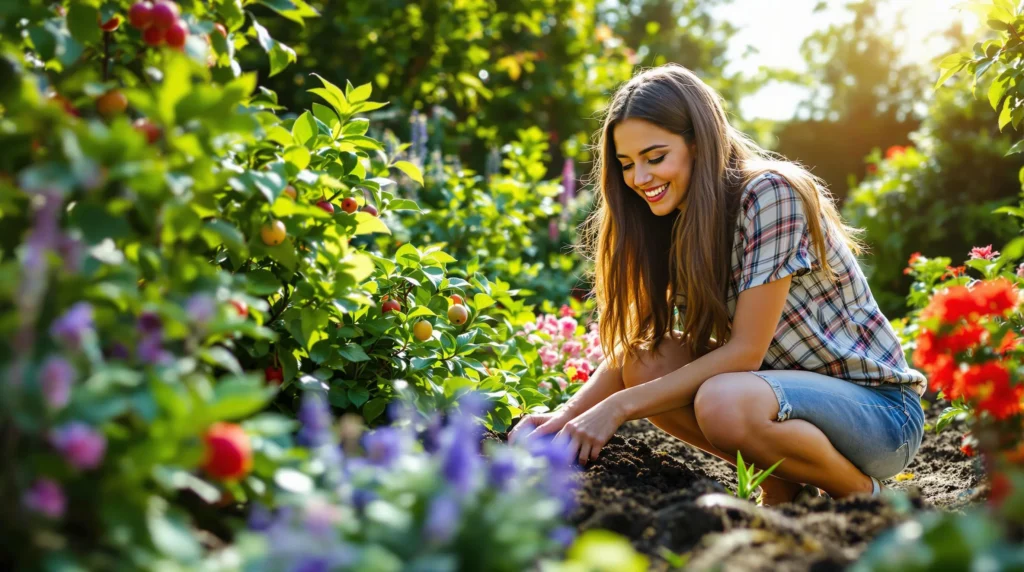What Is a Forest Garden and Why Should You Create One?
A forest garden is a sustainable, low-maintenance network that mimics natural woodland structures while incorporating edible plants, herbs, fruit trees, and beneficial species. Unlike traditional gardens that require constant attention, forest gardens work with nature rather than against it. They feature multiple layers—from tall canopy trees down to ground covers—creating a self-sustaining environment where plants support each other. You’ll benefit from creating a forest garden through reduced maintenance needs, increased biodiversity, year-round harvests, and climate resilience. These gardens help combat climate change by sequestering carbon, provide habitat for beneficial wildlife like pollinators, and offer fresher, more nutritious food right outside your door. Whether you have acres of land or just a small urban plot, forest gardening principles can transform your outdoor space into an abundant, beautiful food-producing industry that connects you more deeply with natural cycles.
10 Essential Forest Garden Layers to Include in Your Design
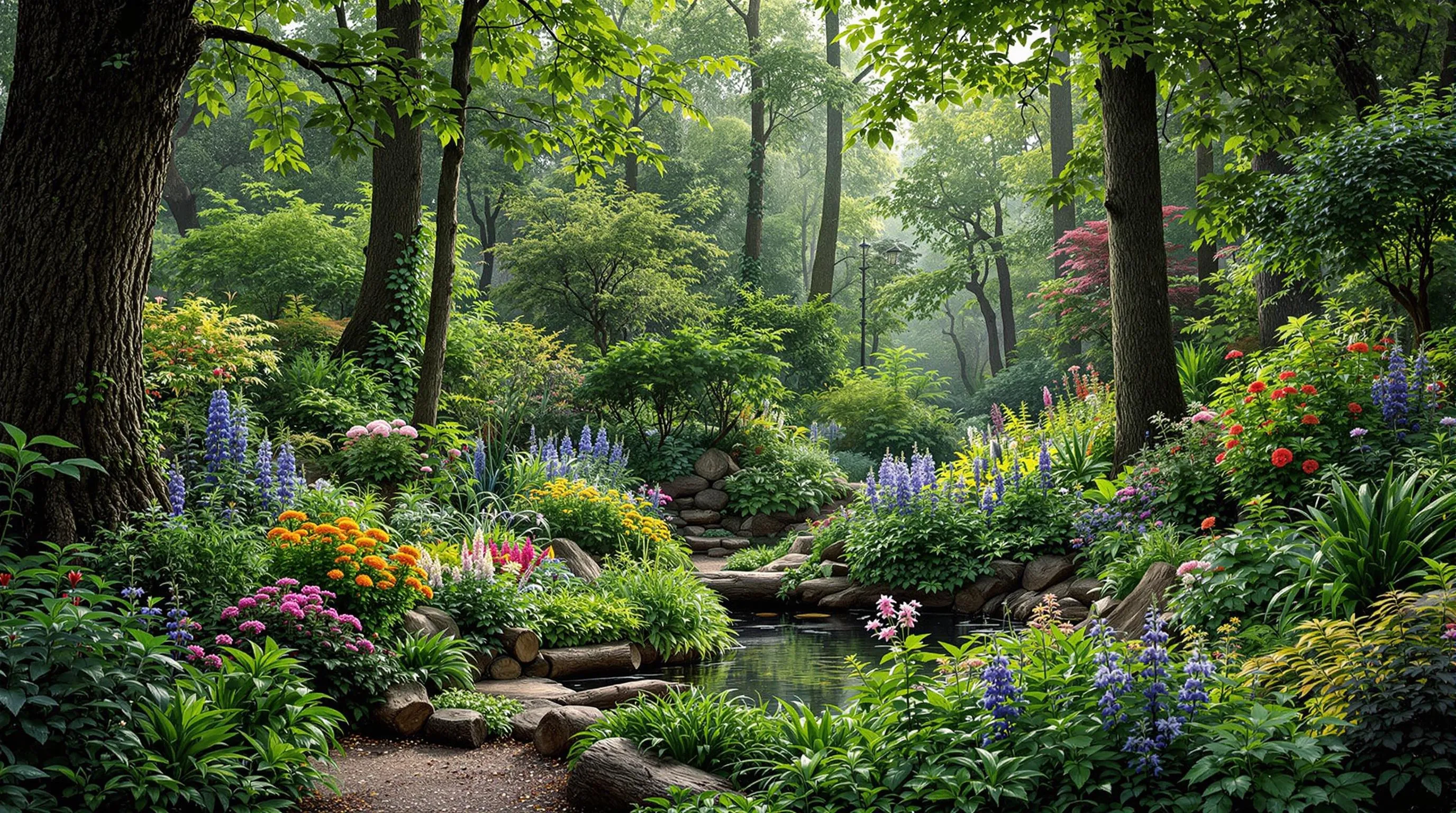
A successful forest garden mimics the structure of natural woodland ecosystems by incorporating multiple layers of vegetation. Each layer serves exact functions and contributes to the overall productivity and resilience of your garden.
Canopy Layer: Tall Trees for Structure and Shade
The canopy layer forms the uppermost structure of your forest garden, typically consisting of full-sized trees reaching 30-80 feet tall. Choose productive species like walnuts, chestnuts, or heritage apple varieties that provide food while creating essential shade patterns for understory plants. These trees also serve as windbreaks, habitat for birds, and carbon sinks. When selecting canopy trees, consider their mature size and spacing requirements to ensure they won’t overshadow your entire garden.
Understory Layer: Smaller Trees for Diversity
Understory trees grow 10-30 feet tall and thrive in the dappled light beneath the canopy. This layer adds productive diversity with species like dwarf fruit trees, serviceberries, and pawpaws. These trees fill vertical space efficiently while producing valuable yields of fruits and nuts. They’re perfect for smaller gardens where full-sized canopy trees might be impractical. Plant understory trees along the northern edge of your garden to maximize sun exposure or intersperse them between canopy trees.
Shrub Layer: Creating Middle-Height Productivity
Shrubs form a crucial middle layer at 3-10 feet tall, offering abundant harvests in relatively compact spaces. Incorporate productive shrubs like blueberries, elderberries, hazelnuts, and currants to create food-producing hedges or clusters throughout your garden. This layer excels at edge plantings and can form natural boundaries while supporting beneficial insects and birds. Many shrubs produce reliably even in partial shade, making them versatile components in any forest garden design.
Herbaceous Layer: Perennial Plants and Self-Seeders
The herbaceous layer contains non-woody perennials that die back annually but return from their root systems. Fill this 1-3 foot layer with culinary and medicinal herbs, vegetables like asparagus and rhubarb, and flowering plants that attract pollinators. Good choices include comfrey, yarrow, echinacea, and culinary herbs like rosemary and thyme. These plants require minimal maintenance once established and often serve multiple functions, from food production to ever-changing accumulation of nutrients.
Groundcover Layer: Protecting Soil and Preventing Weeds
Groundcover plants spread horizontally rather than vertically, creating living mulch that suppresses weeds and protects soil. Select low-growing edibles like strawberries, creeping thyme, and nasturtiums that form dense mats under taller plants. These species prevent erosion, retain moisture, and add productive capacity to otherwise unused ground space. Many groundcovers also flower abundantly, supporting pollinators and adding visual interest to the garden floor.
Vertical Layer: Climbing Plants and Vines
The vertical layer utilizes the three-dimensional space in your forest garden by growing upward on supports, trees, or shrubs. Incorporate productive climbers like grapes, kiwis, hops, and runner beans to maximize yields without expanding your garden’s footprint. These plants efficiently capture sunlight that might otherwise go unused between taller elements. Install trellises, arbors, or simply allow these plants to scramble up existing trees to add another dimension of productivity to your forest garden.
Root Layer: Utilizing Underground Space Efficiently
The root layer occupies soil space with edible roots, tubers, and rhizomes that harvest sunlight aboveground but store energy below. Plant root crops like Jerusalem artichokes, groundnuts, and ramps that thrive in forest settings without extensive cultivation. This often-overlooked layer allows you to grow food in soil spaces that would otherwise remain unproductive. Many root crops can be harvested selectively while allowing the plants to continue growing, providing sustainable yields for years.
Aquatic Layer: Incorporating Water Features
If your site allows, adding an aquatic layer brings multiple benefits to your forest garden. Even small water features like ponds or rain gardens support beneficial amphibians that control pests, provide irrigation reserves, and allow cultivation of edible aquatics like watercress and arrowhead. Water creates diverse microclimates, attracts wildlife, and adds resilience to your garden during dry periods. Position water features to capture runoff and maximize their ecological functions.
Fungal Layer: Mushrooms and Mycelial Networks
The fungal layer operates both visibly and invisibly throughout your forest garden. Cultivate edible mushrooms like shiitake and oyster varieties on logs placed in shady areas, or introduce beneficial mycorrhizal fungi when planting trees and shrubs. This layer breaks down woody debris, accelerates nutrient cycling, and forms beneficial relationships with plant roots. Many fungi also produce valuable harvests while requiring minimal space and maintenance.
Insect and Animal Layer: Supporting Beneficial Wildlife
The final layer isn’t something you plant directly but rather the beneficial wildlife your forest garden attracts and supports. Design with habitat features like brush piles, bee hotels, and bird houses to encourage natural pest controllers. Leave some areas undisturbed for ground-nesting bees and beneficial insects. This layer provides crucial pollination services and natural pest management while creating a vibrant, living network. The more diverse your plant selections in the other layers, the richer this wildlife layer becomes.
7 Beautiful Forest Garden Design Ideas for Different Spaces

Ready to transform your outdoor space into a thriving forest garden? Here are seven design ideas customized for different environments and climate zones to inspire your next permaculture project.
Small Urban Forest Garden Design
Transform your limited city space into a productive mini-forest garden by focusing on vertical growing answers. Use wall trellises for climbing berries, stackable containers for herbs, and dwarf fruit trees in strategic corners. Maximize your small footprint with multi-functional plants like nasturtiums that provide edible flowers, leaves, and natural pest control. Include compact berry bushes like blueberries in containers and herbs like mint and thyme as ground covers. Urban forest gardens thrive when you incorporate space-saving techniques such as espalier fruit trees against sunny walls and hanging planters for trailing strawberries.
Suburban Backyard Food Forest Layout
Your suburban yard offers the perfect canvas for a comprehensive seven-layer forest garden. Arrange fruit trees like apples and pears around the perimeter to create a privacy screen while establishing your canopy layer. Fill the middle areas with productive shrubs such as hazelnuts, elderberries, and currants. Create winding pathways lined with herbs and perennial vegetables like sorrel and asparagus. Dedicate sunny spots to annual garden beds that can rotate crops. Incorporate compost areas in discrete corners to complete the nutrient cycle. This design balances productivity with aesthetic appeal, making it neighborhood-friendly while yielding abundant harvests.
Rural Permaculture-Based Forest Garden Plan
Leverage your expanded rural space to create distinct forest garden “rooms” based on microclimates and land features. Establish windbreaks using nitrogen-fixing trees like alders on the prevailing wind side. Design swales and berms to capture and direct water flow to thirsty plants. Include larger nut trees like walnuts and chestnuts for long-term food security. Create dedicated areas for medicinal herbs, timber species, and wildlife corridors. Incorporate grazing animals like chickens or ducks for pest management and soil fertility. Your rural design can include water features like ponds that serve both wildlife and irrigation needs while creating diverse habitats throughout your property.
Woodland Edge Forest Garden Transition
Create a seamless transition between existing woodland and your cultivated space by mimicking nature’s edge habitats. Plant early-flowering shrubs like serviceberry and elderberry along the woodland periphery to extend the foraging season. Introduce patches of shade-tolerant edibles like ramps, ginseng, and mushroom logs in the dappled light zones. Use existing mature trees as support for grape vines and hardy kiwi. Establish patches of woodland strawberries and native edibles that complement the existing network. This design works with natural succession patterns, creating productive edges where forest meets clearing—typically the most biologically diverse and productive zones in nature.
Mediterranean-Style Forest Garden Concept
Design your drought-resistant forest garden with climate-appropriate species that thrive with minimal irrigation. Center your layout around olive trees, pomegranates, and figs that provide both shade and food. Incorporate aromatic herbs like rosemary, lavender, and thyme as understory plants that attract pollinators and repel pests. Add drought-tolerant groundcovers like creeping thyme and oregano to suppress weeds and retain soil moisture. Create terraced beds on sloped areas to maximize water retention. Include stone pathways and seating areas that absorb heat during the day and release it at night, creating favorable microclimates for heat-loving crops while extending your outdoor living space.
Tropical Forest Garden Abundance System
Harness the explosive growth potential of tropical climates with a multilayered system featuring rapid-growing productive species. Establish tall papaya, banana, and coconut palms as your upper canopy. Plant breadfruit and jackfruit as mid-level trees with avocados and citrus in partly shaded positions. Fill understory areas with pineapples, taro, and sweet potatoes that thrive in filtered light. Use chayote vines and passion fruit as vertical elements. Create mulched growing areas for ginger, turmeric, and galangal that benefit from the rich organic matter. This design capitalizes on the quick cycling of nutrients in tropical systems, producing abundant harvests year-round while building soil through constant organic matter contribution.
Temperate Climate Forest Garden Model
Design a four-season food forest that provides harvests throughout the year in variable climates. Select cold-hardy fruit trees like apples, pears, and plums as your backbone, with hazelnuts and elderberries forming the shrub layer. Incorporate early-producing perennials like asparagus and rhubarb that emerge before tree canopies leaf out. Plant shade-tolerant currants and gooseberries under partial tree cover. Use season-extending techniques like south-facing stone walls that reflect heat to neighboring plants. Include winter-accessible crops like sunchokes and parsnips that can be harvested even in cold months. This design emphasizes resilience through diversity, with multiple plants performing similar functions to ensure production even though seasonal weather fluctuations.
12 Must-Have Plants for Your Forest Food Garden
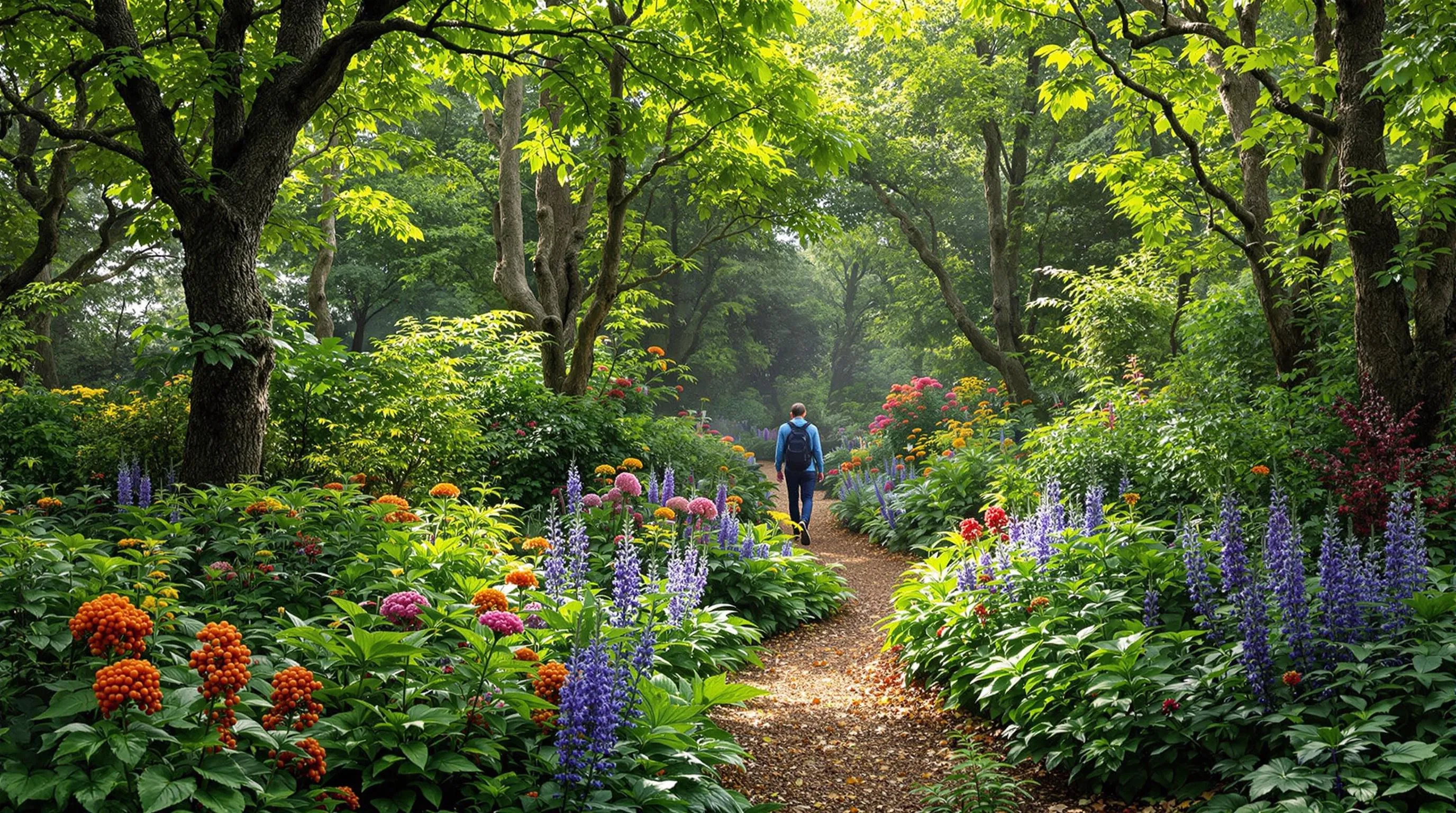
Creating a thriving forest garden requires selecting the right combination of plants that work together in a harmonious network. Here are the essential plants that will form the backbone of your productive food forest, organized by their functional layers and benefits.
Productive Fruit and Nut Trees to Consider
Fruit and nut trees form the vital canopy and understory layers of your forest garden. Apple trees (Malus domestica) offer versatile production with thousands of varieties suited to different climate zones, while providing habitat for beneficial insects. Hazelnuts (Corylus avellana) thrive in partial shade and produce nutritious nuts rich in protein and healthy fats. Pawpaw (Asimina triloba), North America’s largest native fruit, produces custard-like fruits with tropical flavor while adapting well to forest conditions. For warmer climates, mulberry trees (Morus alba or Morus nigra) deliver abundant sweet fruits over several months with minimal care. Consider adding Chinese chestnuts (Castanea mollissima) for their blight resistance and protein-rich nuts that can be a staple food source for your household.
Beneficial Berry-Producing Shrubs
Berry shrubs create an essential middle layer in your forest garden network. Elderberry (Sambucus nigra) produces antioxidant-rich berries while attracting pollinators with its fragrant flowers. Serviceberry (Amelanchier spp.) offers early-season blueberry-like fruits and spectacular spring blooms. Gooseberries and currants (Ribes spp.) thrive in dappled shade conditions where many other fruiting plants struggle. Sea buckthorn (Hippophae rhamnoides) produces vitamin C-packed orange berries and fixes nitrogen to improve soil health. For groundcover and edge areas, strawberries (Fragaria spp.) provide sweet harvests while suppressing weeds and reducing soil erosion with their spreading habit.
Perennial Vegetables That Thrive in Forest Gardens
Perennial vegetables require less maintenance than annuals while providing reliable harvests year after year. Asparagus (Asparagus officinalis) produces tender spring shoots for up to 20 years once established in sunny forest garden edges. Rhubarb (Rheum rhabarbarum) thrives in partial shade with minimal care, offering tart stems for pies and preserves. Walking onions (Allium × proliferum) replant themselves through bulblets formed on top of their stalks, providing perennial allium flavor. Good King Henry (Chenopodium bonus-henricus) offers spinach-like leaves and asparagus-like shoots from the same hardy plant. Turkish rocket (Bunias orientalis) delivers mustard-family flavor with drought resistance and early spring emergence when few other greens are available.
Medicinal Plants to Incorporate
Medicinal herbs add healing properties while supporting overall garden health. Echinacea (Echinacea purpurea) strengthens immune function while attracting crucial pollinators with its striking purple flowers. Yarrow (Achillea millefolium) serves as a ever-changing accumulator, pulling nutrients from deep soil layers while offering medicinal properties for fever reduction. Lemon balm (Melissa officinalis) brings calming benefits alongside its ability to attract beneficial insects with its citrusy scent. Elderflower (from Sambucus nigra) doubles as medicine for respiratory issues while its berries provide immune-boosting properties. California poppy (Eschscholzia californica) offers mild sedative effects while tolerating poor soil conditions and adding vibrant color to forest garden edges.
Nitrogen-Fixing Plants for Soil Health
Nitrogen-fixing plants are essential for maintaining fertility without external inputs. Goumi (Elaeagnus multiflora) produces tangy red berries while enriching surrounding soil through nitrogen fixation. Siberian pea shrub (Caragana arborescens) creates edible pea-like seeds while contributing important nitrogen to your garden system. Clover (Trifolium spp.) works perfectly as a ground cover, fixing nitrogen while providing forage for beneficial insects. Black locust (Robinia pseudoacacia) offers fast-growing timber and honey-producing flowers while significantly improving soil fertility. Autumn olive (Elaeagnus umbellata), even though being invasive in some regions, can be carefully managed to provide berries rich in lycopene while building soil nutrition through nitrogen fixation.
8 Forest Garden Maintenance Tips for Year-Round Success
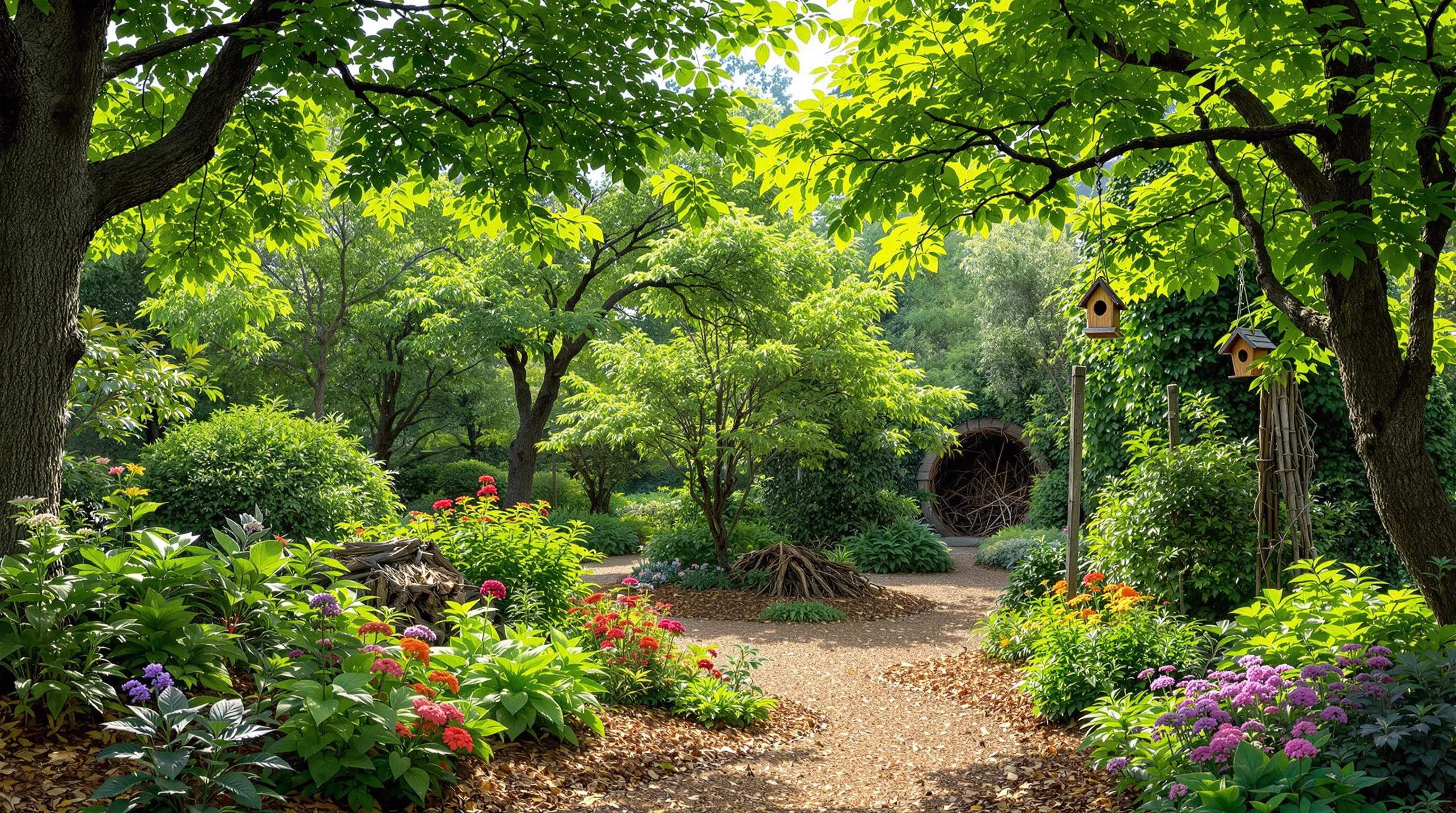
Maintaining your forest garden requires different approaches than conventional gardening. These strategies will help your edible network thrive with minimal intervention while maximizing productivity throughout the seasons.
Seasonal Pruning and Management Strategies
Prune your forest garden strategically according to each season’s needs. In winter, focus on structural pruning of deciduous trees and shrubs while they’re dormant. Spring calls for removing damaged branches and selective thinning to improve airflow. Summer maintenance should include light pruning of water sprouts and removal of diseased material. Fall is ideal for clearing fallen fruit and preparing plants for winter dormancy. Always use the “chop and drop” method—cutting unwanted growth and leaving it on the ground as mulch—to recycle nutrients directly back into your system without creating waste.
Soil Building Techniques for Forest Gardens
Build rich, living soil by mimicking natural forest floor processes. Apply 3-4 inches of organic mulch annually using leaves, wood chips, or straw to suppress weeds and feed soil organisms. Incorporate ever-changing accumulators like comfrey and yarrow that mine nutrients from deep soil layers and concentrate them in their leaves. Create on-site compost to recycle garden waste and introduce mushroom species like wine cap stropharia to break down woody material. Avoid digging or tilling to preserve soil structure and mycorrhizal networks that support plant health. For struggling areas, apply compost tea monthly during the growing season to boost microbial activity.
Managing Plant Competition and Succession
Balance competition between plants by understanding their growth habits and resource needs. Space sun-loving canopy trees 15-20 feet apart to allow adequate light penetration. Plant shade-tolerant species beneath established trees and use groundcovers strategically to suppress aggressive plants. Monitor spreading species like mint or comfrey by planting them in contained areas or using root barriers. Embrace natural succession by allowing some self-seeding but remove unwanted volunteers before they establish. Replace short-lived pioneer species with longer-lived perennials as your garden matures, and create deliberate plant guilds where companions support each other’s growth requirements.
Wildlife Management in Your Forest Garden
Create a balanced network where beneficial wildlife helps manage pests naturally. Install bird houses, bat boxes, and insect hotels to attract natural predators that control pest populations. Maintain small brush piles as habitat for beneficial insects and small mammals like hedgehogs that eat slugs. Plant diverse flowering species that bloom sequentially throughout the year to support pollinators continuously. For larger unwanted visitors like deer, install 8-foot fencing or plant thorny barrier hedges using hawthorn or blackberry. Consider integrating domestic animals like chickens on rotation to help with pest control, but protect vulnerable plants with temporary fencing during foraging sessions.
How to Start Your Forest Garden: A Step-by-Step Guide
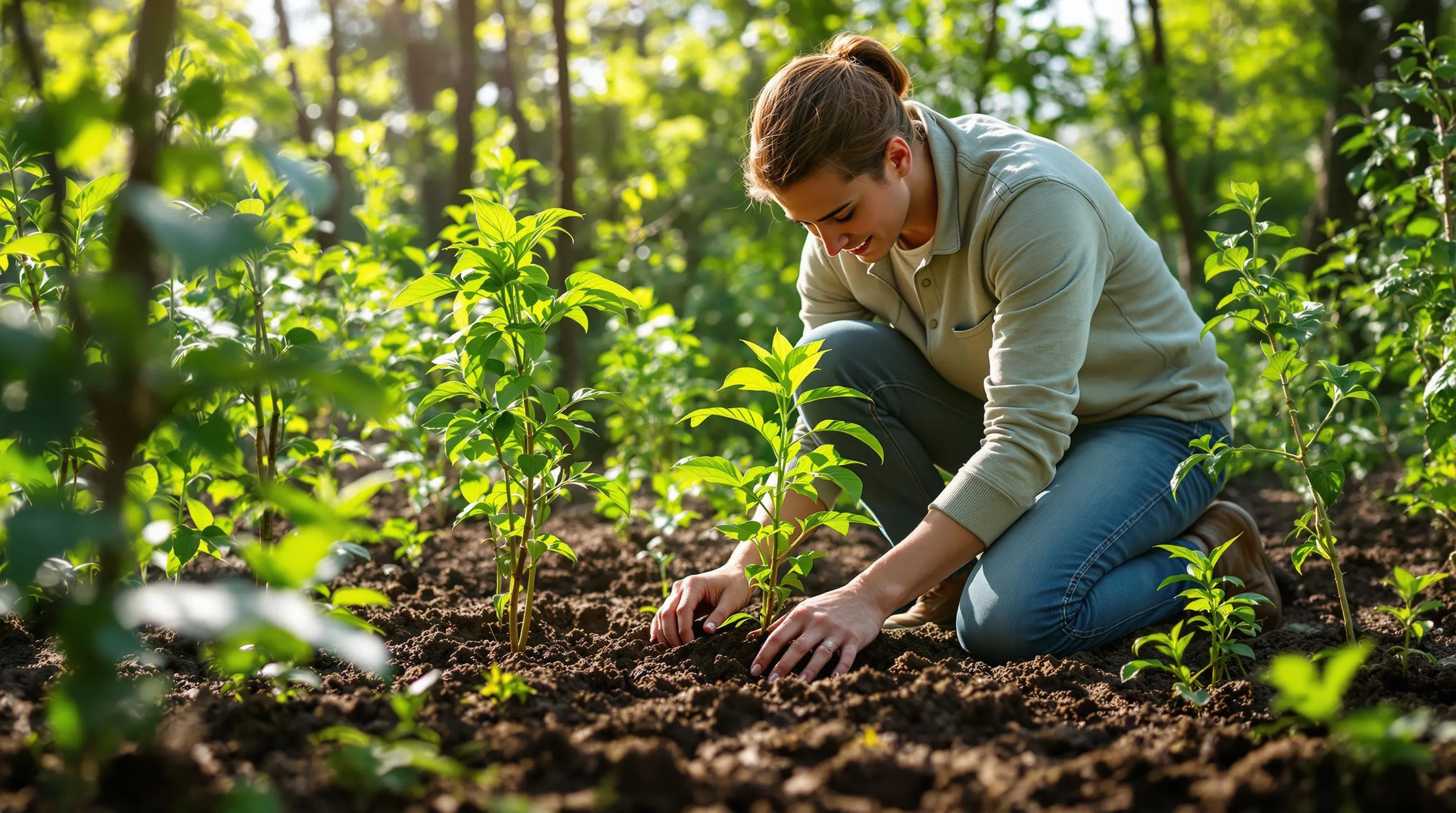
Creating your own forest garden requires careful planning and patience. The following steps will guide you through the process of establishing a thriving, self-sustaining network in your yard.
Site Assessment and Planning
Start your forest garden journey by thoroughly assessing your site’s unique characteristics. Observe sunlight patterns throughout the day, noting areas with full sun, partial shade, and deep shade. Map existing features like mature trees, structures, slopes, and water flow after rainfall. Test your soil pH, texture, and fertility using a simple soil test kit to understand what amendments might be needed. Identify microclimates in your yard—areas that are warmer, cooler, wetter, or drier than surrounding spaces. Consider your climate zone, average rainfall, and typical frost dates to select appropriate plants. Create a scaled drawing of your space, marking all these observations before designing your plant layout. Remember to plan access paths for harvesting and maintenance, and consider how your garden will connect with surrounding landscapes.
Initial Planting Strategies
Begin establishing your forest garden by planting the largest elements first—your canopy and understory trees. Select species adapted to your climate that provide multiple functions like food, medicine, or nitrogen fixation. Install windbreaks on the prevailing wind side to protect young plants if needed. Prepare planting holes twice as wide as the root ball but no deeper, incorporating compost and mycorrhizal fungi to boost early growth. Space trees according to their mature size, considering their full canopy spread. Between these anchor plants, establish nitrogen-fixing shrubs and support species that will improve soil conditions. Use sheet mulching techniques (layering cardboard, compost, and wood chips) to suppress grass and weeds while building soil. Plant groundcovers immediately to prevent soil erosion and weed establishment. Focus on establishing the garden’s structure in the first year rather than maximizing production.
Long-Term Development Timeline
Your forest garden will evolve through distinct phases over several years. Years 1-2 focus on establishment, when regular watering of woody plants is crucial, especially during dry periods. Apply organic mulch annually to suppress weeds and build soil while protecting young plants from competition. During years 3-5, your garden enters its structural development phase as trees and shrubs mature and begin producing. This is the time to add understory perennials as the canopy develops and creates appropriate light conditions. Observe which volunteer plants appear and decide which to keep based on their functions. By years 6-10, your forest garden reaches its productive maturity with established tree canopies, thriving understory plants, and increasing yields. At this stage, focus on managing plant succession, selectively pruning to maintain light levels, and propagating successful species to fill gaps. Throughout this timeline, document plant performance, yields, and wildlife interactions to inform your ongoing management decisions.
Common Forest Garden Mistakes and How to Avoid Them
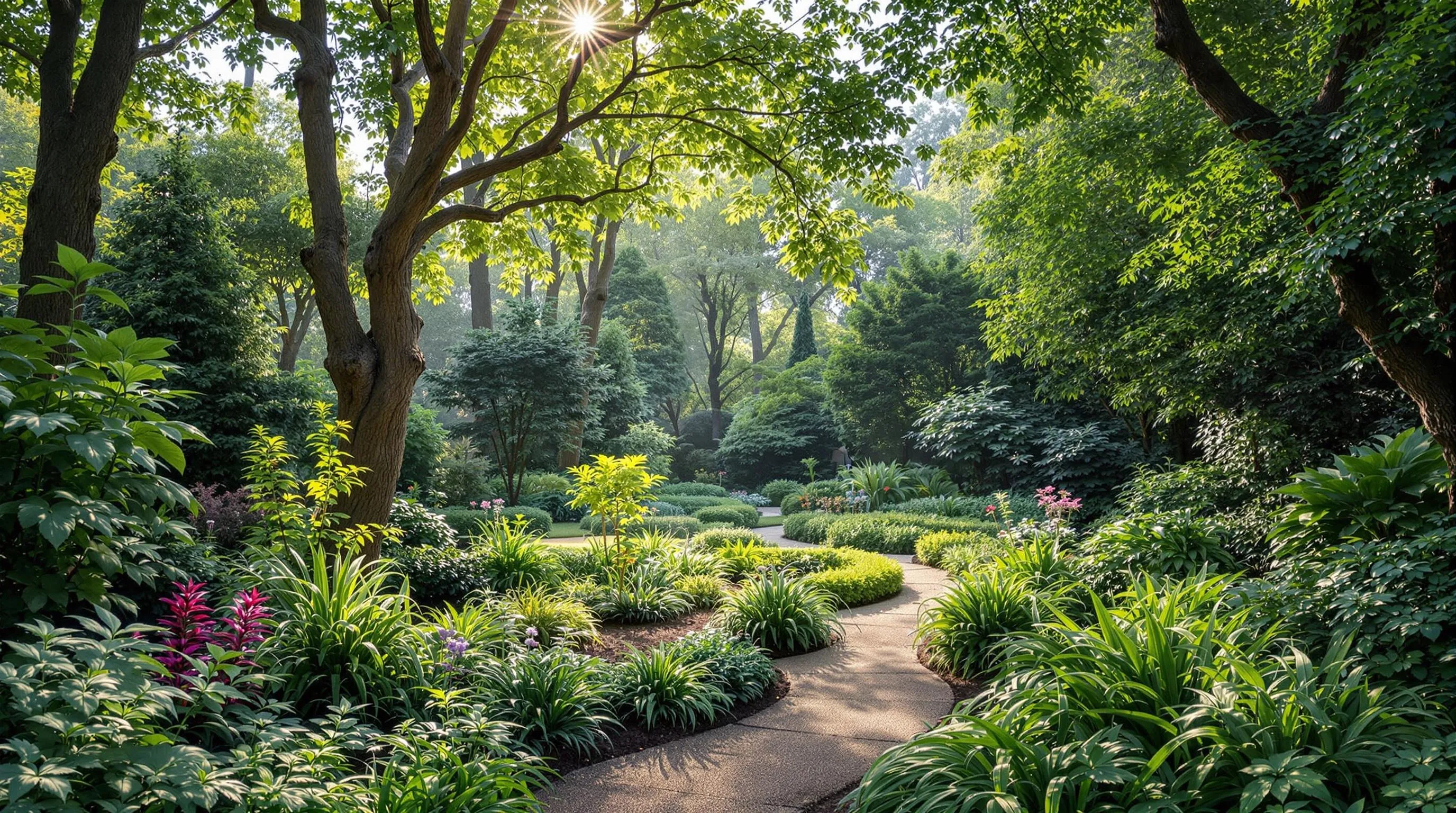
Creating a forest garden isn’t always smooth sailing, even for experienced gardeners. By recognizing these common pitfalls, you’ll save time, resources, and frustration on your forest gardening journey. Overcrowding plants is a frequent mistake—remember to account for mature sizes when planning your layout, allowing at least 80% of a plant’s mature width in spacing. Many gardeners also rush the process, attempting to establish all seven layers simultaneously rather than starting with trees and gradually adding lower layers over 2-3 years. Poor species selection can lead to struggles; always choose plants adapted to your exact climate zone and soil conditions. Neglecting soil preparation before planting significantly impacts long-term success—invest time in sheet mulching and adding organic matter several months before planting. Ignoring microclimates within your garden wastes potential; map sun patterns, frost pockets, and wind tunnels to match plants to their ideal locations. Planting in straight rows contradicts forest garden principles; instead, use curved, natural groupings that mimic woodland edges. Finally, failing to manage aggressive spreaders like mint or comfrey can result in these plants dominating your garden—contain them with barriers or choose less vigorous varieties to maintain the balance in your forest network.
Harvesting From Your Forest Garden Through the Seasons
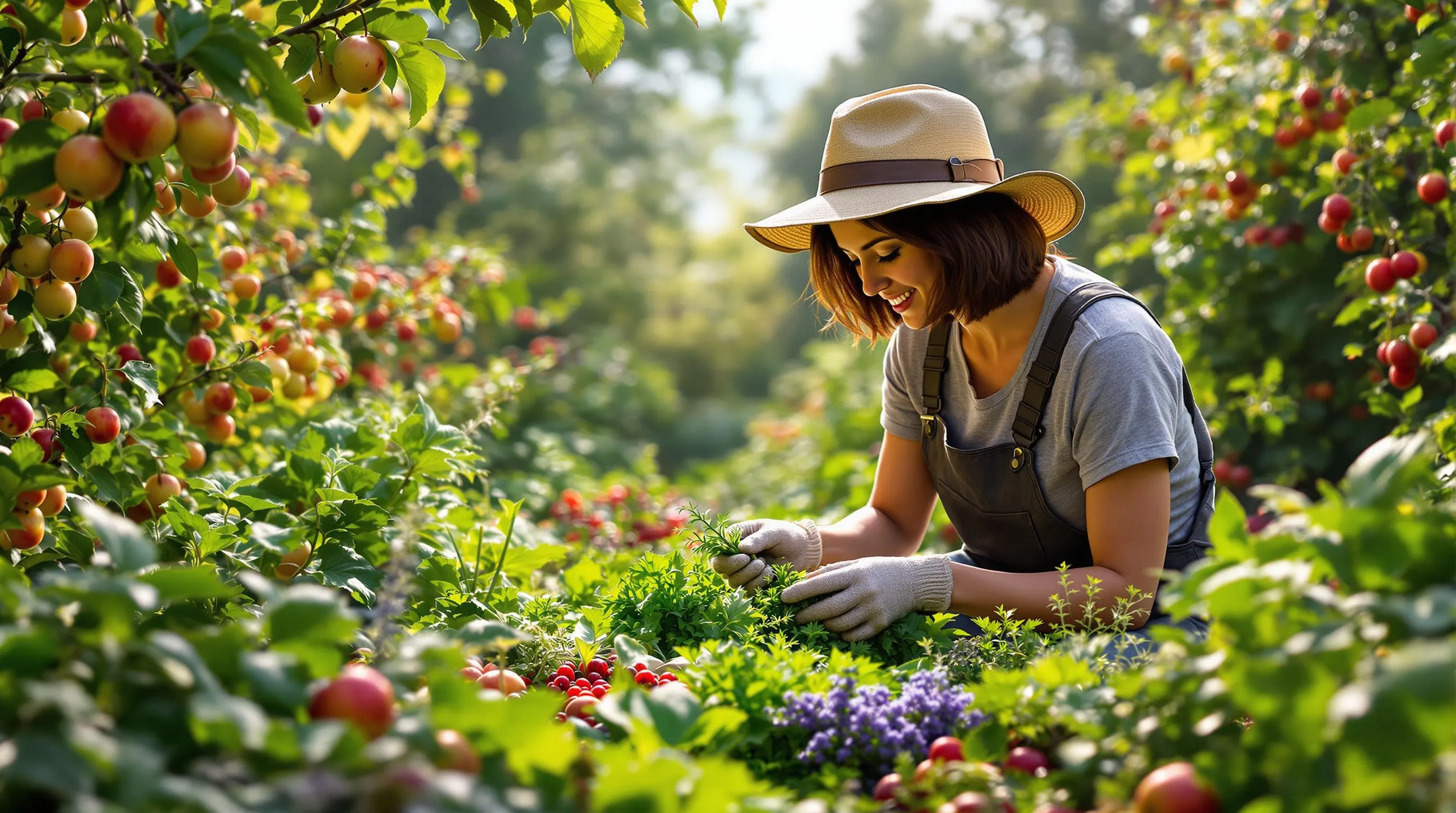
One of the greatest rewards of forest gardening is the continuous harvest it provides throughout the year. Unlike conventional gardens with distinct growing seasons, your forest garden offers diverse yields in every season. In spring, harvest tender shoots, early greens like sorrel, and woodland herbs such as ramps and nettles. Summer brings an abundance of berries, from strawberries and raspberries to currants and gooseberries, alongside perennial vegetables like asparagus and tree fruits. Fall offers a bounty of nuts (walnuts, hazelnuts, chestnuts), late fruits (apples, pears, pawpaws), and medicinal roots. Even winter provides harvests—persimmons after frost, evergreen herbs, and nutritious shoots like bamboo. Develop a harvesting calendar exact to your garden’s plants, noting when each species reaches peak flavor and nutrition. Practice sustainable harvesting techniques by never taking more than one-third of any plant, using proper tools like sharp pruners for clean cuts, and rotating harvest areas to prevent overharvesting. This approach ensures your forest garden remains productive year after year while maintaining ecological balance.
Conclusion: Creating Your Forest Garden Paradise
Your forest garden journey transforms ordinary outdoor space into a thriving network that feeds both body and soul. By working with nature rather than against it you’ll create a resilient industry that demands less work while delivering more rewards.
Start small observe closely and allow your garden to evolve naturally. Remember that forest gardening isn’t just about food production—it’s about fostering biodiversity restoring ecological balance and creating a sustainable legacy for generations to come.
Whether you have acres of land or just a small urban plot the principles remain the same: layer your plantings build healthy soil and welcome wildlife as partners. Your forest garden will become more beautiful productive and self-sustaining with each passing season.

